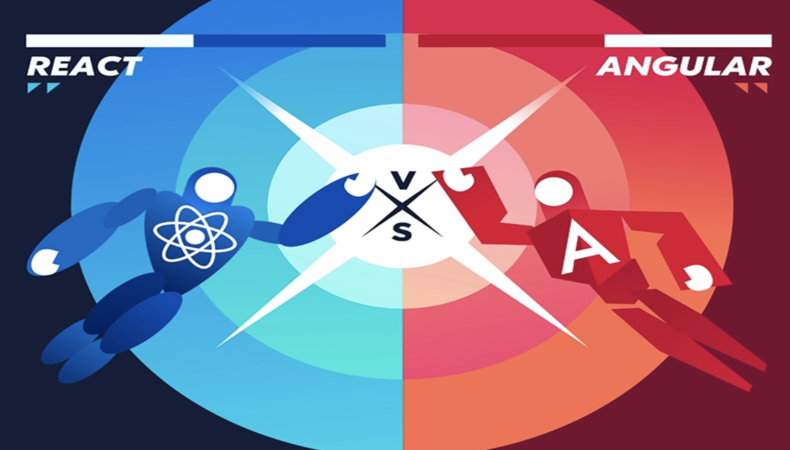
Wonder what's the difference between React and Angular in terms of usage? Normally, you can guess the popularity of the development framework by the rank of brand names that decided to leverage it for their product building. WhatsApp, Netflix, Facebook, Discord, and the New York Times are among a few prominent services built with the help of React. You may start thinking that’s what you need to develop your solution with, but don’t hurry up. What if I’d tell you that Upwork, Google, Samsung, IBM, and Forbes weren’t working the way they do without Angular?
Well, now, you at least know that both technologies are more or less equal in popularity as Front-end developer’s tools. But there are so many other factors you need to account for that we’ve collected all that in a separate article. We’ll compare Angular vs React in all the shades of importance—read on!
Overview of Angular and React frameworks
Let Angular come first. Nowadays it’s one of the most prominent web frameworks, which was produced by Google in 2010. It became an absolute hit at the time of entering the development scene for three reasons:
- It was released and backed by a tech giant.
- It allowed engineers to modify data in one place (the input box) and simultaneously reflect the change on the other end (the property value in the component class), which is called two-way binding.
- It gave developers the capacity to reuse the code by means of dependency injection.
When to use Angular vs React then?
- To save your development time. Angular provides detailed documentation, significantly reducing engineers’ time in finding the exact answer to the popular problem and solving it.
- To cut down coding efforts. If you’re thrilled by the idea of building a fast app, take advantage of Angular because it detects errors at the early stage of development and has clean code.
- To stop thinking about code types. The module structure is another peculiar feature of Angular, which makes structuring your app’s functionality easier, differentiating it all into features and reusable components.
In its turn, React is a framework, usually perceived as an open-source JavaScript library. It was born three years later—in 2013—thanks to Facebook. It’s fertile soil for Front-end development because of:
- Modular and cohesive components. They can be reused and improved to speed up the development process and adjust the logical part to mobile devices.
- Easy translation of logic to mobile apps. That’s truly the fit when you’re considering the possible need to adjust your web solutions from desktop to mobile.
- Smooth maintenance. With React, any change will be easier realized because its components are self-contained.
When we talk about the common use scenarios, that’s the other difference between Angular and React, as React is traditionally used when you need to:
- Handle fast updates. A developer doesn’t need to reload the page with each change made, so data flow is what differs React from the traditional approach to accepting new updates to data.
- Quickly learn the basics. React framework is notoriously easy to learn and use, which means that you, as a client, will have a broader pool of talents for the developer’s role.
- Prioritize SEO friendliness. If reducing loading time and improving your search engine ranking makes sense to you, choose React.
Is the picture getting clearer? Well, we’re pleased. Go on for more details!
Advantages of React
If you’re still weighing ReactJS or Angular, take a look at the major distinctions of React first:
- React has a shorter learning curve because of its design straightforwardness (HTML-like syntax) and support of templates.
- This framework takes less developer’s time because of process automation, which makes it very appealing for startups.
- It’s a perfect choice if you need to create a UI for single-page apps based on isolated components.
- React also suits equally well for the development of complex apps, allowing developers to refer to third-party libraries.
- You can handle both web and mobile app development tasks with the help of React due to its flexibility.
- It gives solid coverage of popular development concerns through the available guides.
- React allows engineers to build robust content-based solutions, regarding its server-side rendering potential.
Advantages of Angular
Now it’s time to contrast Angular versus React through the list of its intrinsic characteristics:
- Angular provides engineers with the ability to develop lightning-fast applications, saving time on code writing.
- The improved efficiency of the ecosystem permits doing everything in one place, significantly reducing efforts.
- Google support is another crucial factor to consider when giving your preference to Angular—the framework is constantly evolving and enhancing development opportunities.
- Angular masterfully copes with finding and eliminating errors at the early SDLC stage.
- The developers value Angular for code cleanness, which evokes less opposition against learning.
- Seamless updates are another perk in the ‘for Angular’ basket, which facilitates the improvement process.
- Angular allows convenient routing from one view to another to simplify the developer’s tasks.
Comparing React and Angular
Finally, let’s sum up Angular and React differences in a table format for you to see all the main distinctions at once.
Angular vs. React: Which one is the better choice for your project?
Well, now that you know the peculiarities of each framework, it should be easier to come up with a decision. Meanwhile, remember that both technologies are great for different purposes, so everything depends on what your project needs. Not to error, come to Patternica for the professional choice of the framework—we’ll consult and implement the solution for your business needs.


